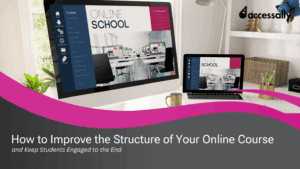Introduction and Overview: Creating High-Converting Webinar Funnels
Webinar funnels have become the cornerstone of successful lead generation for course creators and membership site owners. When done right, they offer a perfect blend of value delivery and relationship building while attracting precisely the type of students who will benefit most from your offerings. But creating an effective webinar funnel involves much more than just scheduling a presentation and hoping people show up.
Think of your webinar funnel as a carefully orchestrated journey that transforms curious prospects into qualified leads. It starts with targeted advertising or content that speaks directly to your ideal student’s pain points, guides them through a registration process that builds anticipation, delivers compelling live or automated presentation content, and culminates in a clear call-to-action that naturally leads to your paid offering.
The key elements of a successful webinar funnel include strategic landing pages that convert, email sequences that nurture engagement before and after the event, compelling presentation content that demonstrates your expertise, and follow-up systems that guide qualified leads toward becoming paying students. Each component needs to work in harmony while maintaining focus on your ideal student’s transformation journey.
Throughout this guide, we’ll explore how to craft each element of your webinar funnel to maximize both lead quantity and quality. You’ll learn practical strategies for qualifying leads early in the process, delivering genuine value during your presentation, and creating natural transition points that guide the right prospects toward enrollment. Whether you’re just starting with webinars or looking to optimize your existing funnel, these proven approaches will help you build a system that consistently attracts and converts your ideal students.
Foundation Concepts and Planning
Before diving into the technical setup of your webinar funnel, it’s essential to lay a strong foundation that will attract and convert the right leads. When done right, webinar funnels can become one of your most powerful lead generation tools, but success starts with careful planning and a clear understanding of your target audience.
Start by defining your ideal participant profile. Think beyond basic demographics and consider their specific pain points, goals, and where they are in their journey. Are they complete beginners looking for introductory guidance, or experienced professionals seeking advanced strategies? This understanding will shape everything from your webinar content to your promotional messaging.
Your webinar topic should strike the perfect balance between providing immediate value and creating desire for your paid offering. Consider structuring your content as a complete framework that solves one specific problem while naturally leading into your broader solution. For example, if you’re selling a comprehensive course on email marketing, your webinar might focus on crafting the perfect welcome sequence – providing actionable value while demonstrating your expertise.
The timing and format of your webinar deserve careful consideration. While live webinars create urgency and engagement, automated webinars can scale your reach without requiring constant time investment. Consider starting with live sessions to gather audience feedback and perfect your presentation, then transition to an automated format once you’ve optimized the content and flow.


Your registration page needs to communicate clear, compelling benefits that speak directly to your ideal participant’s desires. Focus on 3-4 concrete takeaways they’ll gain from attending, and consider including social proof from past participants or results from your methodology. Remember that the quality of your sign-up page often determines the quality of your leads.
| Feature | Benefit | Use Case |
|---|---|---|
| Drip Content | Increases engagement | Course progression control |
| Quiz & Assessments | Validates learning | Student progress tracking |
| Certificates | Motivates completion | Professional development |
| Community Access | Builds loyalty | Student interaction |
Finally, map out your follow-up sequence before launching your webinar. Plan how you’ll nurture both attendees and no-shows, segment your audience based on their engagement, and guide qualified leads toward your offer. This preparation ensures you can capitalize on the momentum generated during your webinar and convert interest into enrollment.
Step-by-Step Implementation Guide
Let’s break down the process of creating a webinar funnel that consistently brings in qualified leads for your online courses. When done right, a well-structured webinar funnel can become your most reliable source of engaged students who are ready to invest in their transformation.
Start by identifying your ideal webinar topic. This should be a pressing problem your target audience faces that directly connects to your course offering. For example, if you’re selling a course on email marketing, your webinar might focus on “3 Email Sequences That Double Your Open Rates” – specific enough to attract the right people, but broad enough to leave them wanting more.
Next, design your registration page with intentionality. Include a compelling headline that speaks to your audience’s desired outcome, 3-4 clear bullet points highlighting what they’ll learn, and a strong bio that establishes your expertise. Keep the form fields minimal – name and email are usually sufficient at this stage. Any additional information can be gathered through post-registration surveys.
The confirmation process is crucial for attendance rates. Set up an immediate confirmation email that includes calendar links for easy scheduling. Follow this with a strategic email sequence: a reminder 1 week before, 1 day before, and 1 hour before the webinar. Each email should build anticipation by sharing a valuable tip or insight related to your topic.
During the webinar itself, structure your content in three distinct segments. Begin with a powerful story that hooks attention and establishes relatability. Move into your main content, teaching something immediately actionable that demonstrates your expertise. Finally, transition smoothly into your offer by showing how your course provides the complete solution to their challenges.
Your follow-up sequence deserves as much attention as the webinar itself. Create three different email paths: one for live attendees who didn’t purchase, another for registrants who didn’t attend, and a third for replay viewers. Each sequence should address specific objections and provide additional value while maintaining momentum toward your course enrollment.
Track your key metrics at each stage: registration rate, attendance rate, engagement during the webinar (measured through chat activity and poll participation), and conversion rate to course enrollment. Use these insights to refine your approach – perhaps your registration page needs stronger social proof, or your webinar content needs more concrete examples.
Remember that your first webinar funnel won’t be perfect, and that’s okay. Focus on delivering genuine value and building authentic connections with your audience. Continuously gather feedback and make incremental improvements to each element of your funnel.
Advanced Strategies and Techniques for Webinar Funnel Success
Let’s dive into some sophisticated approaches that can dramatically improve your webinar funnel performance. When done right, your webinar funnel should work like a well-oiled machine, seamlessly guiding qualified prospects through their decision-making journey.
Start by implementing progressive profiling in your registration process. Instead of overwhelming potential attendees with a lengthy form, collect basic information upfront and gather additional data through strategic touchpoints before and after the webinar. This approach typically increases registration completion rates by 25-35% while still providing you with rich prospect data.
Consider creating multiple registration paths based on your audience’s awareness level. Someone who knows your brand well might receive a different pre-webinar sequence than a cold lead. This personalization can be achieved by asking one simple question during registration: “How did you hear about us?” The answer can trigger specific email sequences and content delivery that resonates with their particular stage in the buyer’s journey.
One often-overlooked strategy is leveraging micro-commitments throughout the funnel. Rather than jumping straight from webinar registration to your high-ticket offer, create smaller engagement opportunities. This could include downloading a companion workbook, participating in a pre-webinar survey, or joining a private community discussion. Each interaction builds investment and trust. For a structured approach to planning these touchpoints, check out our guide on creating a winning content calendar.
Focus on building anticipation through strategic content dripping. Release sneak peeks, expert interviews, or case studies in the days leading up to your webinar. This not only keeps registrants engaged but also primes them for your core message. Consider using a 3-2-1 countdown approach, where each day brings increasingly valuable content that ties directly to your webinar’s main topic.
Finally, implement a robust follow-up system that extends beyond the standard replay email. Create different follow-up sequences based on webinar attendance and engagement levels. Someone who stayed until the end and asked questions should receive different communication than someone who registered but didn’t attend. This targeted approach typically results in a 40-50% higher conversion rate compared to one-size-fits-all follow-up sequences.
| Feature | AccessAlly | Alternative |
|---|---|---|
| Course Creation | ✅ Advanced drag-drop builder | ❌ Basic editor only |
| Member Management | ✅ Built-in CRM system | ❌ Requires third-party tools |
| Payment Processing | ✅ Multiple gateways supported | ❌ Limited options |
| Integration | ✅ WordPress native | ❌ External platform |
Common Challenges and Solutions in Webinar Funnel Creation
When building webinar funnels, even experienced course creators encounter several recurring challenges. One of the most common hurdles is attracting the right audience to register for your webinar in the first place. If you’re feeling stuck with low registration numbers, consider partnering with complementary businesses or influencers in your niche to expand your reach. This approach not only increases visibility but often brings in more qualified leads who are genuinely interested in your offering.
Another significant challenge is maintaining engagement throughout the entire funnel process. Many registrants drop off before the webinar or fail to take action afterward. To combat this, implement a strategic email sequence that builds anticipation before the event. Send valuable snippets of information, case studies, or quick wins that demonstrate your expertise while keeping participants excited about the upcoming webinar.
Technical issues can also derail even the best-planned webinar funnels. Always conduct a full technical rehearsal at least 24 hours before your live event. Test your presentation slides, practice screen sharing, and ensure your audio quality is crystal clear. Have a backup internet connection ready and prepare simplified versions of your visual aids in case you need to switch to a lower-bandwidth option.
Remember that your follow-up sequence is just as crucial as the webinar itself. Create a targeted nurture campaign for both attendees and no-shows, addressing common objections and sharing success stories. Consider offering a time-sensitive bonus or special pricing to encourage quick decision-making, but always maintain authenticity in your approach.
Best Practices and Optimization
When done right, your webinar funnel should operate like a well-oiled machine, consistently attracting and converting quality leads. The key is to focus on optimization at every stage, from registration to follow-up, while maintaining authenticity in your approach.
Start by crafting a compelling registration page that speaks directly to your ideal participant’s pain points. Rather than promising vague benefits, be specific about the transformation they’ll experience. For example, instead of “Learn about course creation,” say “Discover how to create your first online course in 30 days, even if you’re starting from scratch.” This clarity helps attract leads who are genuinely interested in your offering.
Your webinar content should follow a strategic framework that builds trust while demonstrating expertise. Structure your presentation with a clear beginning (establish credibility), middle (deliver actionable value), and end (present your offer). Consider incorporating interactive elements like polls or Q&A sessions to boost engagement and gather valuable insights about your audience’s needs.
Email sequences are crucial for nurturing leads before and after the webinar. Set up a minimum of three pre-webinar emails to build anticipation and reduce no-shows. For those who attend, create a tailored follow-up sequence that addresses common objections and provides additional value. Those who register but don’t attend should receive a different sequence with a recording access option and condensed key takeaways.
Track your key metrics religiously. Focus on registration-to-attendance ratio, engagement during the webinar (questions asked, poll participation), and conversion rates. For deeper insights into creating engaging content that resonates with your audience, check out this comprehensive guide on creating a winning content calendar.
Remember to regularly test and refine different elements of your funnel. Small tweaks to your registration page headline, email subject lines, or call-to-action placement can lead to significant improvements in your conversion rates. The goal is to create a system that not only generates leads but nurtures them effectively into engaged, long-term customers.
Case Studies and Examples
Let’s dive into some real-world examples of successful webinar funnels that have generated exceptional leads. When done right, these funnels can transform casual viewers into engaged prospects who are genuinely interested in your offerings.
Take Sarah, a business coach who was struggling with low-quality leads from her general marketing webinars. She restructured her funnel to include a pre-webinar qualification quiz that helped attendees self-identify their business stage. This simple addition increased her conversion rate from 2% to 8%, as participants arrived better prepared and more aligned with her services.
For comprehensive guidance on course creation platforms, see this detailed analysis from WPBeginner Training Course Showcase.
Another illuminating example comes from Marcus, a digital course creator in the photography niche. He noticed that his broad-topic webinars weren’t attracting serious students. His solution? He created three distinct webinar tracks targeting different skill levels: beginners, intermediate, and advanced photographers. By segmenting his audience this way, he saw a 300% increase in qualified leads and a remarkable 40% reduction in post-sale refund requests.
Consider also the case of Elena’s language learning platform. She implemented a unique approach by hosting bilingual micro-webinars – 20-minute sessions that demonstrated her teaching methodology while giving attendees a taste of the immersion experience. This strategy not only improved attendance rates but also resulted in a 65% increase in trial sign-ups from webinar participants.
The most striking example comes from a tech training company that completely reimagined their webinar funnel. Instead of the traditional slide-heavy presentation, they created interactive coding sessions where attendees could follow along in real-time. They included strategic pause points for questions and peer discussion, making the webinar itself a micro-version of their full program. This approach resulted in an impressive 12% conversion rate to their high-ticket training program.
These success stories share common elements: they all focused on precise audience targeting, delivered genuine value during the webinar, and created clear pathways from free content to paid offerings. The key takeaway is that successful webinar funnels aren’t just about attracting large numbers – they’re about attracting the right people and giving them a meaningful preview of what’s to come.
Future Considerations and Conclusion
As you continue developing your webinar funnel strategy, remember that the digital landscape is constantly evolving. When done right, your webinar funnel can become a sustainable lead generation engine that adapts to changing market conditions and audience needs. Consider implementing A/B testing for different elements of your funnel, from email subject lines to landing page designs, to continuously optimize your conversion rates.
Looking ahead, prepare for the increasing demand for mobile-optimized webinar experiences. More professionals are consuming content on their smartphones, so ensure your registration process, reminder emails, and webinar platform are fully mobile-responsive. Additionally, consider incorporating AI-powered chatbots to handle common pre-webinar questions and provide instant support to registrants.
Data privacy regulations continue to evolve, so stay informed about compliance requirements in your target markets. Implement robust data handling practices and be transparent with your audience about how their information will be used. This builds trust and helps maintain a positive relationship with your leads long after the webinar ends.
Remember that your webinar funnel isn’t just about generating leads – it’s about creating meaningful connections that can translate into long-term business relationships. Focus on delivering genuine value through your content, and don’t be afraid to show your personality. Your authenticity will help you stand out in an increasingly crowded digital space.
As you implement these strategies, pay attention to your metrics but don’t become obsessed with numbers. The quality of your leads matters more than quantity. Keep refining your targeting, messaging, and follow-up processes based on actual results and feedback from your audience. Your webinar funnel should be viewed as a living system that grows and improves with your business.







